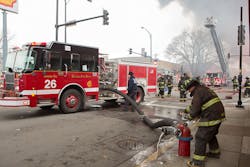Fornell: Hydrant Hook-ups, Chicago Style
While looking through Chicago fire photographer Steve Redick’s collection of photos he shot a few weeks ago at 4-11 alarm fire, something caught my eye.
While the rapidly spreading fire consumed the large warehouse building on Chicago’s West Side, incoming companies were gearing up to stop it in its tracks, and that called for water -- a lot of it.
Chicago’s water system is unusual in that it is of low-pressure, high volume design. Its unlimited water source is Lake Michigan and water surges through its mains at around 35 to 40 psi. While that does not sound like much to those more familiar with higher pressure systems, keep in mind that even with high volumes flowing, the pressure rarely drops more than 15 psi.
Engine 26 took a hydrant at the corner of Western and 21st Street, about half a block from the fire, and as per Chicago SOPs, made the hydrant connection with hard suction, as all extra alarm companies are required to do. Now, as all fire aquaphobes know, you can’t draft from a closed hydrant system, so then, why take the trouble to muscle the hard suction into place?
Simple. The use of hard suction provides an unobstructed 6-inch waterway from the 4 1/2-inch hydrant outlet directly into the pump suction manifold using the large side intakes, guaranteeing minimum friction loss during high-volume operations.
Keep in mind that Chicago uses older style rubber covered hard suction hose that is rated for both drafting and pressurized operation. Some of the newer style transparent plastic hose, while fine for drafting, is not designed to be connected to a pressurized water source.
Once water was obtained, Engine 26 supplied Tower Ladder 54 with an estimated 800 gpm flow, but it didn’t end there.
The engineer (who was actually a firefighter filling in for the regular engineer) stretched a 50-foot length of 4-inch hose from the second port on the hydrant, and attached it to the large intake on the officer’s side of the rig. All Chicago hydrants have an 8 1/2-inch barrel and two 4 1/2-inch outlets. When these were originally designed and installed starting in the 1920s, the practice was to gate the unused port so a second engine could connect to keep hose lead outs short if additional lines were needed. This thinking was spawned in the days of 750 and 1,000-GPM pumps, but now with 1,500-GPM two-stage pumps being standard in the city, it makes more sense to maximize the hydrant and get as much water as possible into the first working engine.
As this fire progressed, a second 4-inch line was run to Tower Ladder 10 and a handline supplied that was taken into an exposure building, all supplied by Engine 26. A retired engineer instructor noted that with all this water flowing, estimated to be about 1,700 gpm, the rig still had 20 psi left on its intake gauge.
For most Chicago fires, the engines reverse lay and connect to hydrants with their preconnected 5-inch front suctions, or run a 4-inch supply line from the nearest hydrant.
There are some lessons to be learned here.
First, is that no matter how your engine is set up, proper training is essential to provide the maximum flow possible. In this case, an acting engineer did everything right because of Chicago’s comprehensive training program.
Second, over the years,Chicago has developed protocols and has designed its pumpers make maximum use of the city’s unique water system.
Third, the system is flexible. For example, if an officer decides to stretch a preconnect on a fire, say, because rapid water is needed in a rescue situation, CFD engines carry 150 feet of 4-inch supply hose on the front bumper in addition to the preconnected 5-inch soft suction. Since Chicago hydrants are located 300 feet’ apart, in theory, you are never more than 150 feet from a plug, so the hydrant-person can stretch a supply line off the front or from the rear main bed to rapidly ensure that the rig has a constant supply of water.
Another example is that Chicago specifies its 4-inch LDH supply hose to be 50-foot lengths rather than the more common 100-foot. Since hydrants are close and streets in many neighborhoods narrow, a 100’ length would be extremely difficult to work with in congested areas.
Sometimes, what appears to be a simple solution is actually the end result of years of experience and thought, designing the right equipment to fit the water system and operating environment.
Of course, you did that when you designed your new engine, or is your department the one that just bought a 2,000 gpm pumper to run in an area with a water system that is maxes out at 750 gpm? Oh well, at least you can win the “mine is bigger than yours” argument.
Steve Redick’s photos of the fire are posted here: http://www.firehouse.com/photostory/10848886/photo-story-flames-consume-chicago-warehouse.
